If you have ever had a Japanese Curry at a restaurant, you probably know about this condiment called Fukujinzuke. It’s made of daikon (white radish) and several other vegetables that are marinated in sweet soy sauce with a touch of sourness. It goes so well with Japanese Curry!
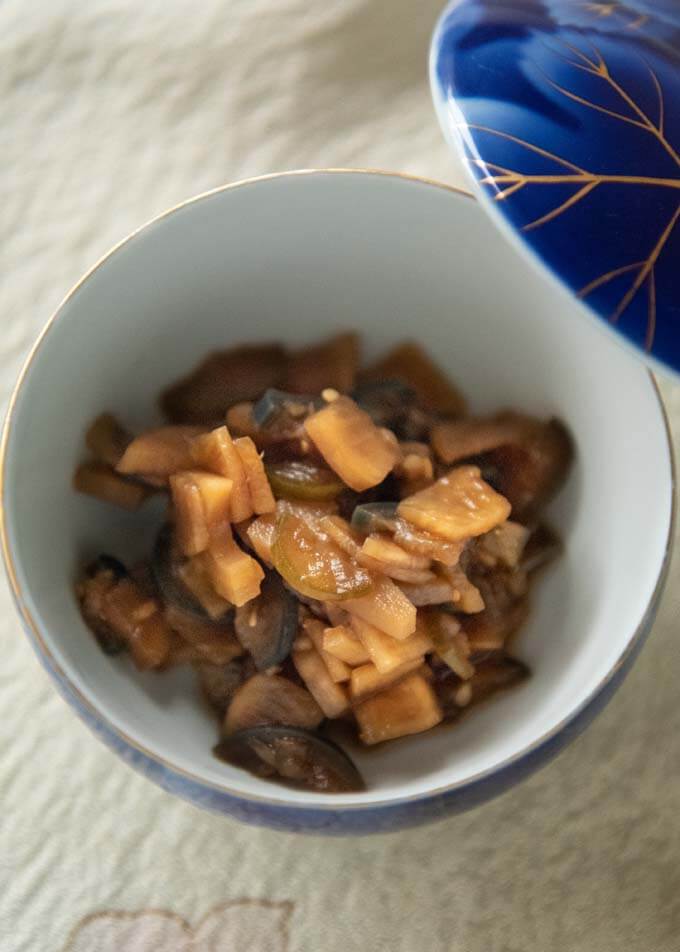
You can buy Fujuinzuke from Japanese grocery stores, but it is quite easy to make at home. I had a request to post Home-made Fukujinzuke from a reader who is fond of Japanese Curry.
What is Fukujinzuke
Fukujinzuke (福神漬け) is a kind of pickle dish but it is not fermented. Daikon, eggplant, sword beans, lotus root, cucumber, etc. are chopped into small thin pieces, then cooked and marinated in a sauce that is made of soy sauce, mirin and other seasonings.
One theory of how the name of this dish came about is associated with the writer in the early Meiji period, Kinga Baitei.
It was so delicious that he thought he wouldn’t need any other dishes, therefore he could save a lot of money, as if the Seven Deities of Good Fortune (Japanese mythology) had come to him.
The Seven Deities of Good Fortune is called ‘Shichifukujin’ (七福神) in Japanese. So the dish is named with the last two Kanji characters ‘fukujin‘ (福神) followed by the word for ‘pickles’ (漬け).
The original Fukujinzuke consisted of 7 different vegetables so it also nicely fit in with Shichifukujin, i.e. Seven Deities.
Vegetables used in Fukujinzuke
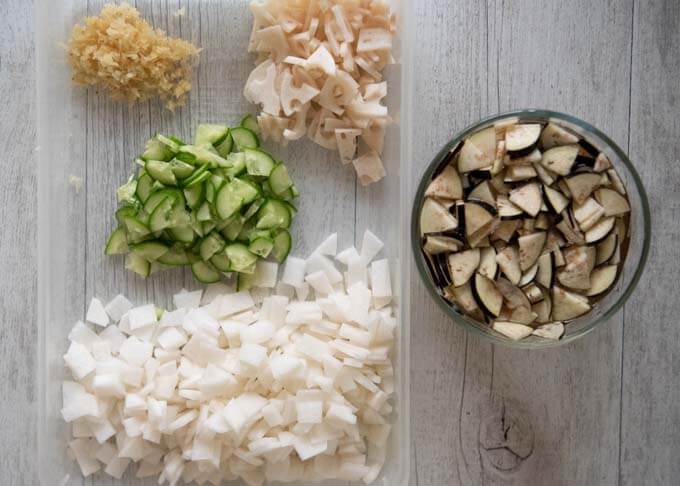
The main vegetable of Fukujinzuke is daikon (white radish). As you can see in my recipe, the proportion of daikon is more than 50% of the total vegetables. So, you could call Fukujinzuke ‘pickled daikon’ in English.
Other vegetables commonly used in Fukujinzuke are:
- Cucumber – any varieties
- Eggplant – any varieties
- Lotus root – fresh or frozen
- Sword beans – young green pods before producing beans
- Turnip
- Shiso (perilla)
- Ginger
Of those vegetables listed above, sword beans would be the most difficult to find at vegetable shops (at least in Sydney). The pods have unique dents lengthwise and when you slice them crosswise, the shape of the sliced piece looks like a sword. Can you see the shape of sword on the right photo below?
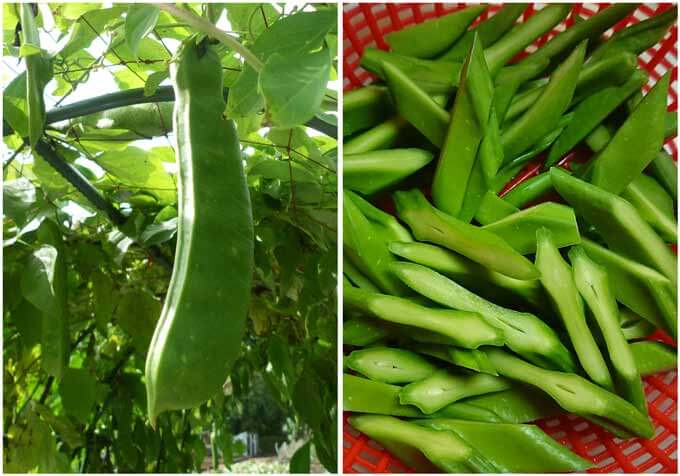
You don’t need to use all the ingredients when making Fukujinzuke at home. But of course, the more the merrier.
How to Make Fukujinzuke
I used daikon, lotus root, cucumber, eggplant and ginger. There are only four steps to make Fukujinzuke:
- Cut all the vegetables into small thin pieces.
- Marinate in salt to extract water from the vegetables.
- Put the vegetables in the marinade and bring it to a boil.
- Leave the vegetables in the marinade with a piece of konbu (dried kelp) overnight.
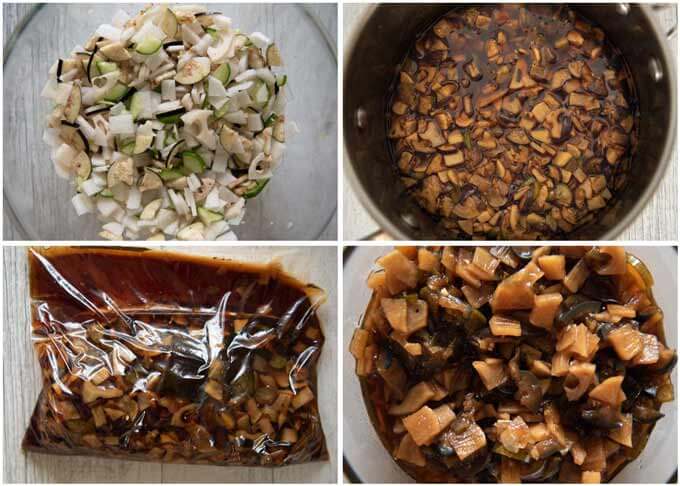
The vegetables are cut to 1-2mm (1⁄16″) thick, 1cm x 1.5cm (⅜” x ⅝”) rectangles. Actually, they do not have to be a rectangles. And in fact, it is impossible to make all the vegetables into a rectangle shape. But it is important to make the size of each piece as small as this rectangle piece.
The marinade consists of soy sauce, mirin, vinegar and sugar.
See the photo below that compares between the Fukujinzuke I made and the store-bought. Putting aside the colour (the store-bought uses red colouring), don’t you think the home-made version looks pretty good?
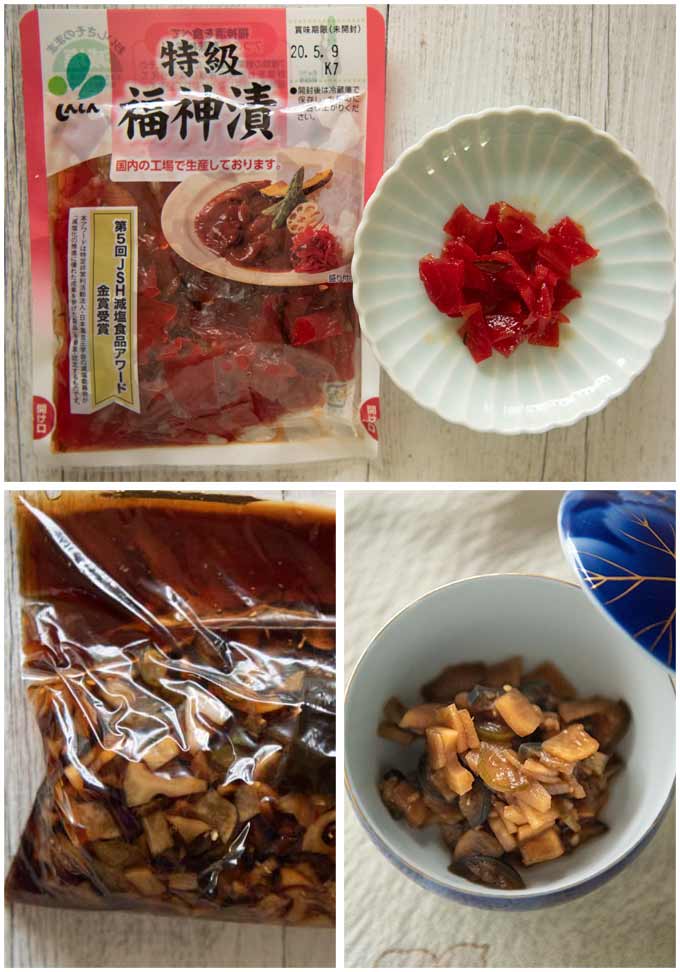
The flavour of store-bought Fukujinzuke is sweeter and it has a stronger acidity. Other difference in flavour is that the store-bought contains shiso (perilla) seeds and it has a distinct shiso flavour which is nice. If I had shiso seeds, I would add to it!
What can go well with Fukujinzuke
The most famous use of Fukujinzuke is as a condiment for Japanese Curry like in the left photo below.
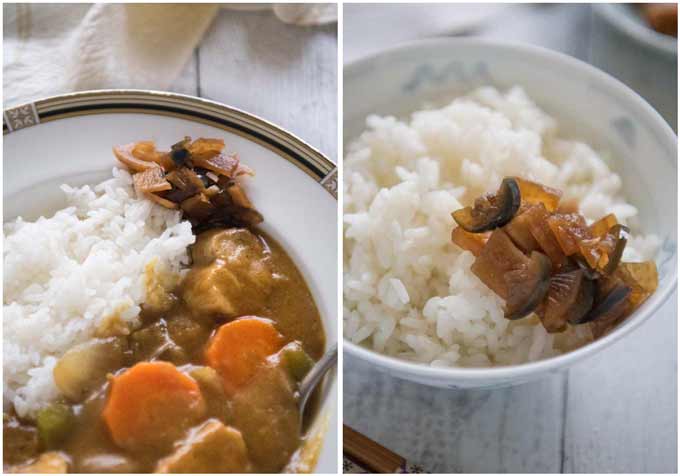
It is also a great condiment for cooked rice (right photo above). You can put a small spoonful of Fukujinzuke on rice and eat them together. I can eat a bowl of rice with just Fukujinzuke.
Instead of using ‘benishōga’ (紅生姜, red pickled ginger) as a topping for Yakisoba (Japanese Stir-fried Noodles), try Fukujinzuke. You can also add Fukujinzuke as one of the ingredients in Japanese Fried Rice (Chāhan).
I think that it can also be one of the fillings in sushi rolls. Instead of making a sushi roll with beef teriyaki and carrot as in my recipe Take Away Sushi Rolls, you can make a Fukujinzuke and carrot sushi roll.
This is not a Japanese dish but I can’t see why you cannot use Fukujinzuke to make Chinese Steamed Buns instead of making them with pork.
I tried several dishes with Fukujinzuke but I must admit that Japanese Curry is the best match for it.
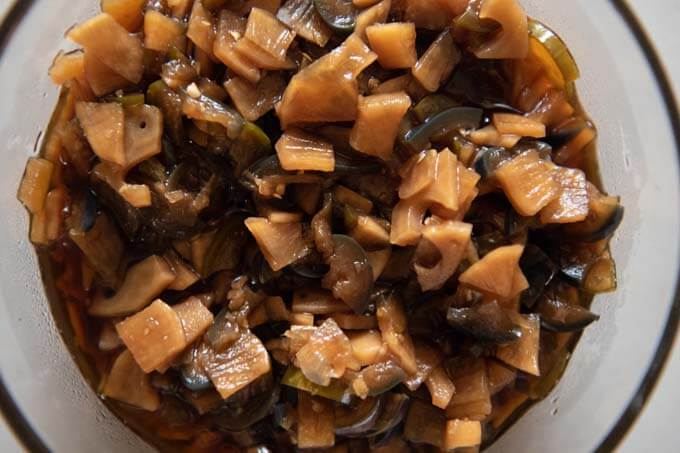
Fukujinzuke keeps 1 week in the fridge. You can also freeze it for a couple of months. Place the leftovers in a zip lock bag, remove the air as much as possible and freeze. Since you wouldn’t consume a large amount of Fukujinzuke at once, you may want to freeze it in small clusters.
Yumiko![]()
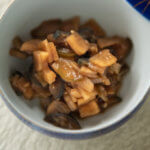
If you have ever had a Japanese Curry at a restaurant, you probably know about this condiment called Fukujinzuke. It’s made of daikon (white radish) and other vegetables and tastes like sweet soy sauce with a touch of sourness.
It is a great vegetarian dish.
Don't forget to see the section 'MEAL IDEAS' below the recipe card! It gives you a list of dishes that I have already posted and this recipe that can make up a complete meal. I hope it is of help to you.
- 200g/7.1oz daikon (white radish)
- 50g/1.8oz lotus root
- 50g/1.8oz cucumber
- 50g/1.8oz eggplant
- 20g/0.7oz ginger , finely chopped
- 1.5 tsp salt
- 1 sheet konbu (dried kelp), 5cm x 5cm/2" x 2"
-
Cut daikon, lotus root, cucumber and eggplant into small rectangular shape of 1cm x 1.5cm/⅜” x ⅝", 1-2mm/1⁄16" thick.
-
Place eggplant pieces in water to prevent them from browning due to oxidisation.
-
Add all the vegetables and ginger to a large bowl and sprinkle salt over the vegetables. Using both hands, mix well so that the salt coats the vegetables evenly. Leave it for 15 minutes.
-
Add water to the bowl of vegetables, then drain. Taking a handful of vegetables at a time, squeeze the water out as much as possible and put all the vegetables into the sauce pan.
-
Add all the Marinade ingredients to the saucepan and bring to a boil.
-
Turn the heat off and cool it down (it is OK to be slightly warm).
-
Transfer the vegetables and the marinade to a zip lock bag. Put the konbu in the bag as well.
-
Remove as much air as possible from the bag and seal the zip.
-
Marinate in the fridge for 24 hours. Drain and serve as needed (note 3).
1. You can use other vegetables. The vegetables commonly used in Fukujinzuke are daikon, cucumber, eggplant, lotus root, sword beans, turnip and shiso (perilla). They all need to be cut to similar sizes.
2. The volume of the marinade is a bit more than required for the amount of vegetables in the ingredients. If you prefer, you could reduce the quantity by about 20%, or increase the amount of vegetables.
The left over marinade can be reused to marinate vegetables.
3. You can re-use the marinade to marinate other vegetables. Alternatively, dilute the marinade with water and use it as the base of clear soup.
4. Fukujinzuke keeps 1 week in the fridge. You can also freeze it for a couple of months. Place the remaining Fukujinzuke in a zip lock bag, remove the air as much as possible and freeze. Since you wouldn’t consume a large amount of Fukujinzuke at once, you may want to freeze it in small clusters.
Meal Ideas
A typical Japanese meal consists of a main dish, a couple of side dishes, a soup and rice. I try to come up with a combination of dishes with a variety of flavours, colours, textures and make-ahead dishes.
Fukujinzuke is a condiment. So I have decided to show you the dishes that go well with it.
- Home-made Fukujinzuke – today’s recipe, make ahead
- As a condiment for Japanese Curry such as Katsu Curry (Japanese Curry with Chicken Cutlet) and Home-made Japanese Vegetarian Curry
- As a condiment for a bowl of rice
- As a topping for Yakisoba (Japanese Stir-fried Noodles) instead of benishōga (red pickled ginger)
- As an ingredient for Japanese Fried Rice (Chāhan)
- As a filling for Take Away Sushi Rolls
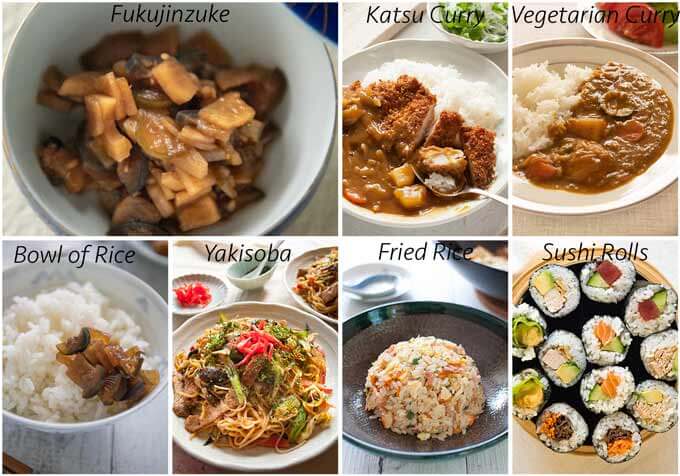
Hi Yumiko,
Like you, I can’t buy perilla/shiso seeds in Australia, but I do have some shiso furikake, usually for mixing into rice. Do you think this might work in place of the shiso seeds? If so, how much would you suggest? Its flavour is quite strong.
Thank you!
Hi Stewart, I have not tried it, but if you want to add some, I would think you only add a very small amount. Furikake usually contain salt and sugar, so the flavour of your Fukujinzuke will become strong if furikake is added too much.
I would like to know if I can use frozen hatsu as in hawaii only new years we have fresh ones.
I enjoys your recipes as its very easy to follow
Hi Hazel, yes you can use frozen hasu (lotus roots).
Hi Yumiko,
What kind of vinegar is best for this dish? Where I’m from I can use white vinegar, apple cider vinegar and Chinese black vinegar. Thanks in advance! I’m excited to make this dish.
Hi Ace, from your list, I would recommend apple cider, which is milder than standard vinegar. Japanese rice wine vinegar does not have as sharp acidity as the standard vinegar. Besides the flavour of Fukujinzuke is sweet that goes well with apple cider vinegar.
Good luck and I hope you like it!
This is perfect! We are living in Japan and have become big fans of the fukujinzuke from Coco Curry. I tried looking for it in various stores (using translate on my phone) but haven’t been too successful so far. Just bought a daikon and will give this recipe a try this week.
Hi Kate, pleas let me know what you think.
Hello, did you try this? I am also looking to remake from cocos
I would like to try this pickle, but I can’t fins any daikon or lotus root. Can I sub the daikon with radishes (properly cut)?
Hi Dodina, I never tried radishes in place of daikon but I think it will work since they are similar in texture and flavour. You may even leave the red skin on. The colour of the fukujinzuke might become slightly red which is great. Some of the store-bought fukujinzuke even has a red colouring added so that it looks more appertising.
Hi Yumiko,
Can fukujinzuke be canned to preserve instead of freezing? I’m looking forward to making this! Thank you!
Hi Lisa, if fukujinzuke is canned in a correct way to preserve it for longer, it can keep longer. But as soon as you open it, it won’t keep more than a week or so. All the articles I read indicate that freezing is the best way to preserve it.
Haha! I think we are all preparing for the apocalypse so canning saves freezer space. But I digress.
I’m looking for the pickles that taste like Coco Curry House’s one. Does this taste similar? I could eat this every day but it’s pretty pricy to get it shipped here.
Thanks
Hi Sabrina, I am not sure if it’s the same flavour as Coco Curry House’s version. Mine might be slightly sweeter. But it still tastes good.
I like sweet so I’ll definitely try this! I was about to make it today. Sent my son to the store to get daikon, and he brought home takuan! (Guess I’m making Kim bap… grrr)
I recall reading the ingredients in English (only in Hawaii) and I remember msg being one of them. Have you tried adding Ajinomoto? Wish I knew what the other veggie they put in there. It had a weird 8 shape.
Also with the lotus root, mine was too hard. Is it supposed to be really hard and crunchy or did I just get a bad one?
Hi Sabrina, I was brought up with Ajinomoto as all households had a bottle and added some to improve the flavour. But in Australia, it was not readily available un less you bought at Japanese grocery stores. So I stopped using it. Some people might still be believing that Ajinomoto is not safe but that’s a myth. It is aWHO approved safe product. Adding it will certainly improve the umami flavour.
The 8-shaped vegetable piece is a sliced sword beans. I talked about it in my post. Lotus root is crunchy but should not be so hard to chew. If very dried and old, it becomes stringy. Try to pick a very heavy root as it means the root contains a lot of water, i.e. fresh.
I hope you like the home-made fukujinzuke.
Hi! Using your recipe, what is the total amount of veggies that will be used – in cup measurements? 1.5? Thank you.
Hi Kerry, it’s a bit tricky. I did not measure in cups and the volume depends on the size of the vegetable pieces. Looking at the photos, I would think it was about 1.5-2 cups of total veggies. Next time, I will remember to measure in cups when chopped like this.